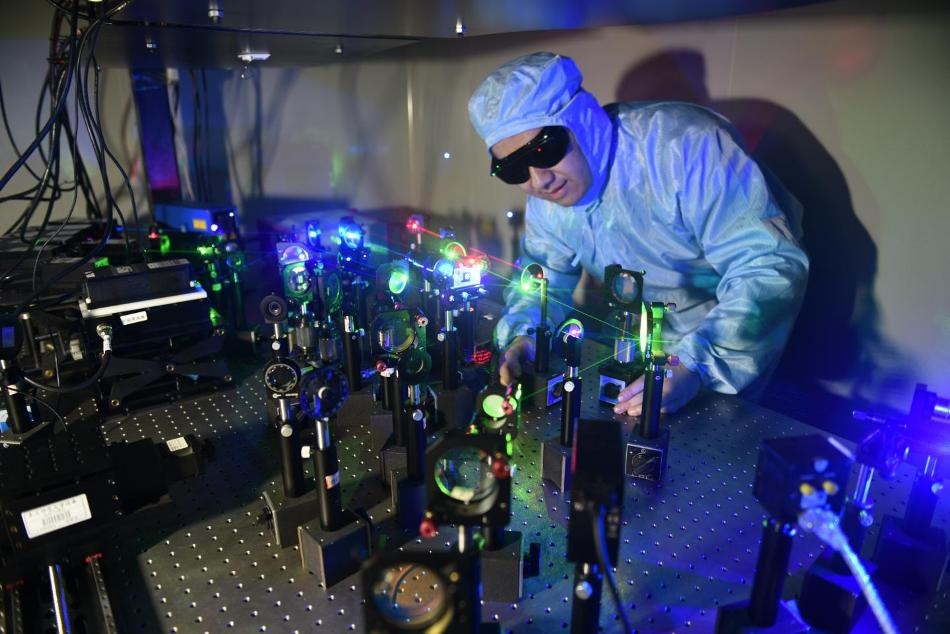Apr 4 2018
The generation of more and more data renders the need for high-density data storage with the ability to stay stable over time highly critical. This need can be met by innovative nanoparticle-based films - more than 80 times thinner when compared to human hair - by providing materials with the ability to holographically store over 1000 times more data than a DVD in a 10 ´ 10 cm piece of film.
The new technology could someday lead to the production of tiny wearable devices with the ability to capture and store 3D images of people or objects.
 Researchers created a nanofilm that can store data holographically and is environmentally stable. Here, Shencheng Fu carries out experiments with the new film. (Image credit: Northeast Normal University)
Researchers created a nanofilm that can store data holographically and is environmentally stable. Here, Shencheng Fu carries out experiments with the new film. (Image credit: Northeast Normal University)
In the future, these new films could be incorporated into a tiny storage chip that records 3D color information that could later be viewed as a 3D hologram with realistic detail. Because the storage medium is environmentally stable, the device could be used outside or even brought into the harsh radiation conditions of outer space.
Shencheng Fu
The scientists have described the fabrication of the innovative films and demonstrated the ability of the technology to be used for an environmentally stable holographic storage system in the Optical Materials Express journal. Apart from holding large amounts of data, the films also enable the data to be retrieved at speeds of nearly 1 GB per second, which is nearly 20 times the reading speed of prevalent flash memory.
Storing More Data in Less Space
The innovative films have been designed to enable holographic data storage, a method that involves using lasers to create and read a 3D holographic recreation of data in a material. Since it can instantly record and read millions of bits, holographic data storage can be done considerably faster than magnetic and optical techniques usually adopted for data storage at present, which record and read individual bits one by one. Holographic techniques are also intrinsically high-density since they record information through the entire 3D volume of the material, not only on the surface, and have the ability to record multiple images in the same area using light at distinctive angles or containing different colors.
In the recent past, scientists have conducted experiments using metal-semiconductor nanocomposites as a medium for the storage of nanoscale holograms that have high spatial resolution. Porous films formed of silver nanoparticles and the semiconductor titania are propitious for this application since they change color upon being exposed to different colors, or wavelengths, of laser light and since a series of 3D images can be recorded at the laser beam’s focus area in a single step. Despite the fact that the films can be used for the storage of multi-wavelength holographic data, it can be seen that exposure to UV light erases the data, rendering the films unstable for long-term information storage.
For recording a holographic image into titania-silver films, a laser is used to transform the silver particles into silver cations that have a positive charge owing to the extra electrons.
We noticed that UV light could erase the data because it caused electrons to transfer from the semiconductor film to the metal nanoparticles, inducing the same photo transformation as the laser. Introducing electron-accepting molecules into the system causes some of the electrons to flow from the semiconductor to these molecules, weakening the ability of UV light to erase the data and creating an environmentally stable high-density data storage medium.
Shencheng Fu
Changing the Electron Flow
To develop the innovative films, the team used electron-accepting molecules measuring just 1–2 nm to interrupt the flow of electrons from the semiconductor to the metal nanoparticles. They developed semiconductor films using a honeycomb nanopore structure that enabled the electron-accepting molecules, the nanoparticles, and the semiconductor to interface with one another. The ultra-small size of the electron-accepting molecules enabled them to get attached to the inner side of the pores without any influence on the pore structure. The thickness of the fabricated films was only 620 nm.
The scientists investigated their innovative films and discovered that holograms can be efficiently stored into them with high stability even when UV light is present. The scientists also showed that multiple electron transferring paths were formed when the electron-acceptors were used to change the electron flow, enabling the material to respond faster to the laser light and considerably increasing the data writing speed.
Particles made from noble metals such as silver are typically viewed as a slow-response media for optical storage. We show that using a new electron transport flow improves the optical response speed of the particles while still maintaining the particle’s other advantages for information storage.
Shencheng Fu
The intention of the researchers is to investigate the environmental stability of the innovative films by carrying out outdoor investigations. They also indicate that in order to enable real-life application of the films, it would be important to develop highly efficient 3D image reconstruction methods and techniques for color presentation for reading or displaying the stored data.